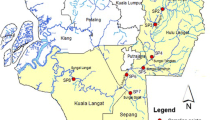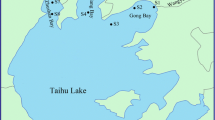Abstract
The presence of sexual hormones (female estrogens) was assessed in sediments of a mangrove located in the urban region of southern Brazil. The estrogens are involved in human sexual reproduction. They act as the chemical messengers, and they are classified as natural and synthetic. The estrogens inputs in the environment are from treated and untreated sewage. The presence of estrogens in sewage is excretion from the female due to natural production and use of contraceptives (synthetic estrogens). With the indiscriminate release of sewage into the environment, estrogens can be found in rivers, lakes, and even in oceans. In this work, the presence of estrone (E1), 17-β-estradiol (E2), and 17-α-ethynilestradiol (EE2) in eight sedimentary stations in Itacorubi mangrove located on Santa Catarina Island, south Brazil, was investigated. Historically, the Itacorubi mangrove has been impacted by anthropogenic activities because the mangrove is inserted in the urban area of the Florianopolis. The estrogen EE2, used as contraceptive, had the highest concentration in mangrove sediment, 129.75 ± 3.89 ng/g. E2 was also found, with its concentration ranging from 0.90 ± 0.03 to 39.77 ± 1.19 ng/g. Following the mechanism, under aerobic or anaerobic conditions, E2 will first be oxidized to E1, which is further oxidized to unknown metabolites and finally to CO2 and water (mineralized). EE2 is oxidized to unknown metabolites and also finally mineralized. Theoretically, under anaerobic conditions, EE2 can be reduced to E1 even in environments such as mangrove which is essentially anaerobic.



Similar content being viewed by others
References
Alder, P., Steger-Hartmann, T., & Kalbfus, W. (2001). Distribution of natural and synthetic estrogenic steroid hormones in water samples from Southern and Middle Germany. Acta Hydrochim. Hydrobiol., 29, 227–241.
Annavarapu, S., Foran, C. M., Gardinali, P., Metzger, C., & Willett, K. L. (2004). Comparison of two sites in mobile bay using in vivo biomarkers in largemouth bass, sediment bioassays, and sediment contaminant analysis. Archives Environmental Contamination Toxicolology, 46, 502–510.
Arnon, S., Dahan, O., Elhanany, S., Cohen, K., Pankratov, I., Gross, A., et al. (2008). Transport of testosterone and estrogen from dairy-farm waste lagoons to groundwater. Environmental Science & Technology, 42(15), 5521–5526.
Bouman, A., Heineman, M. J., & Faas, M. M. (2005). Sex hormones and the immune response in humans. Hum. Repr. Update, 11, 411–423.
Bowman, J. C., Zhou, J. L., & Readman, J. W. (1998). Sediment-water interactions of natural oestrogens under estuarine conditions. Marine Chemistry, 77, 263–276.
Carballa, M., Omil, F., Lema, J. M., Llompart, M., García-Jares, C., Rodríguez, I., et al. (2004). Behavior of pharmaceuticals, cosmetics and hormones in a sewage treatment plant. Water Research, 38(12), 2918–2926.
Froehner, S., & Maceno, M. (2009). Assessment of bioaccumulation of biphenyls in the trophic chain of a coastal area of Parana, Brazil. Environmental Monitoring and Assessment, 164(1–4), 189–198.
Froehner, S., Martins, R. F., & Errera, M. R. (2009). Assessment of fecal sterols in Barigui River sediments in Curitiba, Brazil. Environmental Monitoring and Assessment, 157(1–4), 591–600.
Froehner, S., Souza, D. B., Machado, K. S., & Rosa, E. C. (2010). Tracking anthropogenic inputs in barigui river, brazil using biomarkers. Water, Air, and Soil Pollution, 210, 33–41.
Hoffmann, B., Pinho, T. G., & Schuler, G. (1997). Determination of free and conjugated estrogens in peripheral blood plasma, feces and urine of cattle throughout pregnancy. Experimental Clininic Endocrinology Diabetes, 105, 296–303.
Houtman, J. C., Booij, P., Jover, E., del Rio, D. P., Swart, K., van Velzen, M., et al. (2006). Estrogenic and dioxin-like compounds in sediment from Zierikzee harbour identified with CALUX assay-directed fractionation combined with one and two dimensional gas chromatography analyses. Chemosphere, 65(11), 2244–2252.
Isobe, T., Serizawa, S., Horiguchi, T., Shibata, Y., Managaki, S., Takada, H., et al. (2006). Horizontal distribuition of steroid estrogens in surface sediments in Tokyo Bay. Environmental Pollution, 144, 632–638.
Jobling, S., Nolan, M., Tyler, C. R., Brighty, G., & Sumpter, J. P. (1998). Widespread sexual disruption in wild fish. Environmental Science & Technology, 32(17), 2498–2506.
Johnson, A. C., Belfroid, A., & Di Corcia, A. (2000). Estimating steroid oestrogen inputs into activated sludge treatment works and observations on their removal from the effluent. Science ot the Total Environmental, 256(2–3), 163–173.
Joss, A., Andersen, H., Ternes, T., Richle, P. R., & Siegrist, H. (2004). Removal of estrogens in municipal wastewater treatment under aerobic and anaerobic conditions: consequences for plant optimization. Environmental Science & Technology, 38, 3047–3055.
Jürgens, M. D., Williams, R. J. & Johnson, A. C. (1999). Fate and behaviour of steriod oestrogens in rivers: a scoping study, Institute of Hydrology, Oxon 80 pp.
Lopez de Alda, M. J., Gil, A., Paz, E., & Barcelo, D. (2002). Occurrence and analysis of estrogens and progestogens in river sediments by liquid chromatography-electrospray-mass spectrometry. The Analyst, 127, 1299–1304.
Larsson, D. G. J., Adolfsson-Erici, M., Parkkonen, J., Pettersson, M., Berg, A. H., Olsson, P. E., et al. (1999). Ethinyloestradiol—an undesired fish contraceptive? Aquatic Toxicology, 45, 91–97.
Mes, T., Zeeman, G., & Lettinga, G. (2005). Occurrence and fate of estrone, 17b-estradiol and 17a-ethynylestradiol in STPs for domestic wastewater. Reviews in Environmental Science & Biotechnology, 4(5), 275–311.
Metcalfe, C. D., & Yang, J. J. (2006). Fate of synthetic musks in a domestic wastewater treatment plant and in an agricultural field amended with biosolids. The Science of the Total Environment, 363, 149–165.
Nudi, A., Wagener, A. L. R., Francioni, E., Sette, C. B., Sartori, A. V., & Scofield, A. L. (2010). Biomarkers of PAHs exposure in crabs Ucides cordatus: laboratory assay and field study. Environmental Research, 110, 137–145.
Raman, D. R., Williams, E. L., Layton, A. C., Burns, R. T., Easter, J. P., Daugherty, A. S., et al. (2004). Estrogen content of dairy and swine wastes. Environmental Science & Technology, 38, 3567–3573.
Robinson, B., Hui, J. P., Soo, E., & Hellou, J. (2009). Estrogenic compounds in seawater and sediment from halifax harbour, Nova Scotia, Canada. Environmental Toxicology and Chemistry, 28(1), 18–25.
Saccà, M. L., Accinelli, C., Fick, J., Lindberg, R., & Olsen, B. (2009). Environmental fate of the antiviral drug Tamiflu in two aquatic ecosystems. Chemosphere, 75, 28–33.
Schlenk, D. (2008). Are steroids really the cause for fish feminization? A mini-review of in vitro and in vivo guided TIEs. Marine Pollution Bulletin, 57, 250–254.
Sierra, E. J., Sierra, B. (1998) Man-made nutrient enrichment in a mangrove system of Santa Catarina Island, Brazil: Problems and proposal for restoration. pp. 361–368. In: E.J. Soriano-Sierra & B. Sierra de Ledo (eds.). Ecologia e Gerenciamento do Manguezal de Itacorubí.
Silva, F. S., Laut, V. M., Laut, L. L. M., Figueiredo Jr., A. G., Bonetti, C., Viana, L. G., Crapez, M. A. C. (2005) Avaliação da qualidade ambiental em sedimentos superficiais do estuário do Itacorubi, Baía Norte (SC), utilizando a relação granulometria e atividade respiratória bacteriana. Pp: 1–3. In: Abstract of X Congress of Brazilian Quaternary Association.
Snyder, E. M., Snyder, S. A., Kelly, K. L., Gross, T. S., Villeneuve, D. L., Fitzgerald, S. D., et al. (2004). Reproductive responses of common carp (Cyprinus carpio) exposed in cages to influent of the Las Vegas Wash in Lake Mead, Nevada, from late winter to early spring. Environmental Science & Technology, 38, 6385–6395.
Soto, A. M., & Sonnenschein, C. (2005). Shining a light on sunscreens. Endocrinology, 146, 2127–2129.
Sovernigo, M. H. (2009). The mangrove swamp of Itacorubi, Florianopolis, Brazil: a review of the available ecological data for directing new studies. Oecologia Brasiliensis, 13(4), 575–595. doi:10.4257/oeco.2009.1304.03.
Subramanian, V., Moturi, O. C. Z., & Rawat, M. (2005). Distribution and partitioning of phosphorus in solid waste and sediments from drainage canals in the industrial belt of Delhi, India. Chemosphere, 60(2), 237–244.
Tam, N. F. Y., Ke, L., Wang, X. H., & Wong, Y. S. (2001). Contamination of polycyclic aromatic hydrocarbons in surface sediments of mangroves swamps. Environmental Pollution, 114(2), 255–263.
Ternes, T. A., Stumpf, M., Mueller, J., Haberer, K., Wilken, R. D., & Servos, M. (1999). Behavior and occurrence of estrogens in municipal sewage treatment plants-I. Investigations in Germany, Canada and Brazil. Science of the Total Environmental, 225(1-2), 81–90.
Ternes, T. A., Andersen, H., Gilberg, D., & Bonerz, M. (2002). Determination of estrogens in sludge and sediments by liquid extraction and GC/MS/MS. Analitycal Chemistry, 74, 3498–3504.
Thomas, K. V., Balaam, J., Hurst, M., Nedyalkova, Z., & Mekenyan, O. (2004). Potency and characterization of estrogen-receptor agonists in United Kingdom estuarine sediments. Environmental Toxicology and Chemistry, 23, 471–479.
Xue, B., Yan, C., Lu, H., & Bai, Y. (2009). Mangrove-derived organic carbon in sediment from Zhangjiang Estuary (China) Mangrove Wetland. Journal of Coastal Research, 24(4), 949–956.
Yoshimoto, T., Nagai, F., Fujimoto, J., Watanabe, K., Mizukoshi, H., Makino, T., et al. (2004). Degradation of Estrogens by Rhodococcus zopfii and Rhodococcus equi Isolates from activated sludge in wastewater treatment plants. Applied and Environmental Microbiology, 70(9), 5283–5289.
Young, W. F., Whitehouse, P., Johnson, I., Sorokin, N. (2004) Proposed Predicted-No-Effect-Concentrations (PNECs) for natural and synthetic steroid oestrogens in surface waters. Environmental Agency Bristol, R&D Technical Report P2-T04/1.
Acknowledgments
We thank Dr. Marcelo Bessa for helpful discussions. S. F. thanks CNPq for financial support (Processo 577060/2008-2 and 300448/2009-0).
Author information
Authors and Affiliations
Corresponding author
Rights and permissions
About this article
Cite this article
Froehner, S., Machado, K.S., Stefen, E. et al. Occurrence of Sexual Hormones in Sediments of Mangrove in Brazil. Water Air Soil Pollut 219, 591–599 (2011). https://doi.org/10.1007/s11270-010-0732-2
Received:
Accepted:
Published:
Issue Date:
DOI: https://doi.org/10.1007/s11270-010-0732-2




